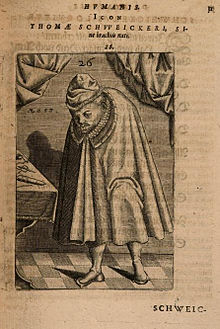Thomas Schweicker
Thomas Schweicker (born December 21, 1541 in Schwäbisch Hall ; † October 7, 1602 there ; according to other information, born in 1540) was an armless art writer.
Live and act
Thomas Schweicker was born in 1541 in the imperial city of Schwäbisch Hall as the son of the baker and councilor Hans Schweicker and his wife Dorothee . Presumably due to a so-called amniotic constriction , he was missing both arms ( Amelie ). Despite his disability, he attended school from the age of seven and switched to the Schwäbisch Hall Latin School at the age of twelve. Not only was he able to independently carry out everyday tasks, such as dressing and undressing or eating and drinking, but he also learned to hold a quill pen with the toes of his right foot and to write.
He lived in the house of his brother David Schweicker on the Rosenbühl, where a plaque commemorates him today. He developed his skills as a calligrapher (pen) to such an extent that he could not only earn a living with it, but also became a celebrity. Schweicker's images are reproduced in numerous publications and pamphlets of his time. Many visitors came to Schwäbisch Hall to see him and to purchase documents written by him. Emperor Maximilian II also belonged to them , who visited the city in 1570 and had Schweicker's art demonstrated. The emperor was impressed and presented him with three double ducats “personally with aigner hand”. In 1584 the emperor had him brought to Heidelberg so that he could show his art in front of the court gathered there; Schweicker stayed in Heidelberg until 1598, where he mainly worked as a painter. As a thank you he received, among other things, an imperial coat of arms letter .
Schweicker, known as the “great miracle man of Schwäbisch Hall”, remained celibate and died on October 7, 1602 at the age of 61. He was buried in the choir of the Michaelskirche . Here you can find his gravestone on the one hand, and the death certificate that he himself calligraphed as a sample of his art on the other.
The Thomas Schweicker secondary school in Schwäbisch Hall is named after him.
literature
- Joachim W. Siener: The calligrapher Thomas Schweicker to Schwäbisch Hall. A search for clues. In: From the Antiquarian Bookshop , No. 4/2009, pp. 221–237.
- Manfred Akermann: Thomas Schweicker, Leonhard Kern, Erasmus Widman. Design of the imperial city in the late Renaissance . Schwäbisch Hall 1989
- Eduard Krüger: A wreath of honor for Thomas Schweicker, the ancient “wonder man” . Writings on St. Michael, H. 1; Schwäbisch Hall 1952
- Ernst Liese: Thomas Schweicker as a person and artist. For the 400th anniversary of the year of his birth . In: Württembergisch Franken NF 20/21 (1939/1940); Pp. 255-288
- E. Püschel: Amelie in the probation of life presented to Thomas Schweicker 1540-1602 . In: Deutsche Medizinische Wochenschrift 28/1963; Pp. 1402-1404
- Hans Scheugl: Show Freaks & Monsters. Felix Adanos Collection . DuMont publishing house: Cologne, 1978; P. 58f .; with fig.
Fiction:
- Wilhelm German: In Rosenbühl. In the footsteps of Thomas Schweickers the wonder man . Roman, Schwäbisch Hall 1927
- Martin Ulbrich: Thomas Schweicker the cripple of Schwäbisch Hall . Historical tale from the sixteenth century, Eisleben 1909
Web links
- Entry in the register of Thomas Schweicker Deus est mirabilis in operibus suis , May 15, 1602. In: Register of the Donauer family , 1599–1608, p. 31; Private ownership ( digital copy from the Regensburg State Library)
- Silver medal (1582) with the picture of Schweicker, holding the stylus with his feet
| personal data | |
|---|---|
| SURNAME | Schweicker, Thomas |
| BRIEF DESCRIPTION | German, armless art writer |
| DATE OF BIRTH | December 21, 1541 |
| PLACE OF BIRTH | Schwäbisch Hall |
| DATE OF DEATH | October 7, 1602 |
| Place of death | Schwäbisch Hall |


